Squatting (Australian history)
Squatting is an historical Australian term that referred to someone who occupied a large tract of Crown land in order to graze livestock. Initially often having no legal rights to the land, squatters gained ownership by being the first (and often the only) European settlers in the area. Eventually, the term "squattocracy", a play on "aristocracy", came into usage to refer to squatters and the social and political power they possessed.
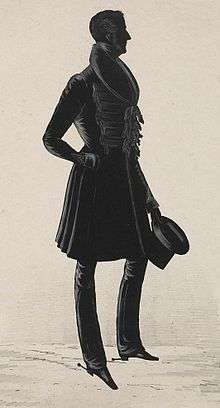
Evolution of meaning
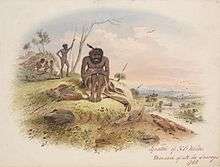
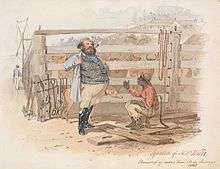
The term ‘squatter’ derives from its English usage as a term of contempt for a person who had taken up residence at a place without having legal claim. The use of ‘squatter’ in the early years of British settlement of Australia had a similar connotation, referring primarily to a person who had ‘squatted’ on 'unoccupied' land for pastoral or other purposes. In its early derogatory context the term was often applied to the illegitimate occupation of land by ticket-of-leave convicts or ex-convicts (emancipists).
From the mid-1820s, however, the occupation of Crown land without legal title became more widespread, often carried out by those from the upper echelons of colonial society. As wool began to be exported to England and the colonial population increased, the occupation of pastoral land for raising cattle and sheep progressively became a more lucrative enterprise. ‘Squatting’ had become so widespread by the mid-1830s that Government policy in New South Wales towards the practice shifted from opposition to regulation and control. By that stage, the term ‘squatter’ was applied to those who occupied Crown land under a lease or license, without the negative connotation of earlier times.
The term soon developed a class association, suggesting an elevated socio-economic status and entrepreneurial attitude. By 1840 squatters were recognized as being amongst the wealthiest men in the colony of New South Wales, many of them from upper and middle-class English and Scottish families. As unoccupied land with frontage to permanent water became more scarce, the acquisition of runs increasingly required larger capital outlays. A "run" is defined in Christopher Pemberton Hodgson's 1846 Reminiscences of Australia, with Hints on the Squatter's Life as: "land claimed by the Squatter as sheepwalks, open, as nature left them, without any improvement from the Squatter."[1]
Eventually the term ‘squatter’ came to refer to a person of high social prestige who grazes livestock on a large scale (whether the station was held by leasehold or freehold title). In Australia the term is still used to describe large landowners, especially in rural areas with a history of pastoral occupation. Hence the term Squattocracy, a play on 'aristocracy'.
Background
When the British settled at Sydney Cove in 1788 the colonial government in Australia claimed all lands for the Crown. Governors of New South Wales were given authority to make land grants to free settlers, emancipists (former convicts) and non-commissioned officers. When land grants were made they were often subject to conditions such as a quit rent (one shilling per 50 acres (200,000 m2) to be paid after five years) and a requirement for the grantee to reside on and cultivate the land. In line with the British government's policy of concentrated land settlement for the colony Governors of New South Wales tended to be prudent in making land grants. By the end of Governor Macquarie’s tenure in 1821 less than 1,000 square miles (2,600 km2) of land had been granted in the colony of New South Wales.
During Governor Brisbane's term, however, land grants were more readily made. In addition regulations introduced during Brisbane’s term enabled settlers to purchase (with his permission) up to 4,000 acres (16 km²) at 5s an acre (with superior quality land priced at 7s 6d). During Governor Brisbane's four years in office the total amount of land in private hands virtually doubled.[2]
The impetus for squatting activities during this early phase was an expanding market for meat as the population of Sydney increased. The first steps in establishing wool production in New South Wales also created an increased demand for land. Squatting activity was often carried out by emancipist and native-born colonists as they sought to define and consolidate their place within society.[3]
Darling and the ‘Limits of Location’
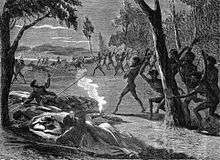

From 1824 there were acts and regulations to limit squatting. The limits of location, also known as the Nineteen Counties, were defined from 1826; beyond these limits land could not be squatted on or subdivided and sold. This was because of the expense of providing government services (police ...etc.) and difficulty supervising convicts over a wide tract of land. However the nature of the sheep industry which required access to vast grassy plains meant that despite the limitations, squatters often occupied land far beyond the colony's official limits. From 1833 Commissioners of Crown Lands were appointed under the Encroachment Act to manage squatting.
From 1836 legislation was passed to legalise squatting with grazing rights available for ten pounds per year. This fee was for a lease of the land, rather than ownership, which is what the squatters wanted. The 1847 Orders in Council divided land into settled, intermediate and unsettled areas, with pastoral leases of one, eight and 14 years for each category respectively. From here on, squatters were able to purchase parts of their land, as opposed to just leasing it.
It is known that many squatters fought battles with advanced European weapons against the local Indigenous Australian communities in the areas they occupied, though such battles were rarely investigated. These battles/massacres are the subject of the history wars, being the term for an ongoing public discussion on Australia's interpretation of its history. Squatters were only occasionally prosecuted for killing indigenous people. The first conviction of white men for the massacre of Indigenous people followed the Myall Creek massacre in 1838, in which Aboriginal subject status was employed by colonial courts for the rare co-incidence of local, colonial and imperial authorities.
Whilst life was initially tough for the squatters, with their huge landholdings many of them became very wealthy and were often described as the "squattocracy". The descendants of these squatters often still own significant tracts of land in rural Australia, though most of the larger holdings have been broken up, or, in more isolated areas, have been sold to corporate interests.
In April 1844 Governor Gipps made two regulations with the intention of remodelling the squatting system. The first, gazetted on 2 April, permitted squatters to occupy runs on payment of £10 for every 20 square miles (52 km2). The second regulation allowed squatters after 5 years occupancy to purchase 320 acres (130 hectares) of a run and gave purchasers security of tenure over a whole run for another 8 years. 150 squatters gathered in Sydney later in the month of April and protested against Gipps's changes drafting a petition to the Queen and forming the Pastoral Association of New South Wales - the first formalising of the identity of squatters as a political group.
A large squatting demonstration was held in Melbourne in June 1844. The lessees of the Crown lands came into Melbourne on horseback, and marched to the place of the meeting with flags flying, preceded by a Highland piper playing martial airs. At this meeting petitions were adopted to be transmitted to the several branches of the Home and Colonial Legislatures, requesting alterations in the law of Crown lands and a total separation from the Middle District (New South Wales). A new association was formed at this meeting, and designated the 'Pastoral Society of Australian Felix'.[4]
Legislation to allow selection
In the 1860s several colonies passed legislation to permit selection.
New South Wales
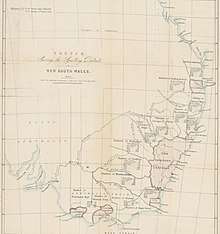
The squatters' grip on agricultural land in the colony of New South Wales was challenged in the 1860s with the passing of Land Acts that allowed those with limited means to acquire land. With the stated intention of encouraging closer settlement and fairer allocation of land by allowing 'free selection before survey', the Land Acts legislation was passed in 1861. The relevant acts were named the Crown Lands Alienation Act and Crown Lands Occupation Act. The application of the legislation was delayed until 1866 in inland areas such as the Riverina where existing squatting leases were still to run their course. In any case severe drought in the Riverina in the late 1860s initially discouraged selection in areas except those close to established townships. Selection activity increased with more favourable seasons in the early 1870s.
Both selectors and squatters used the broad framework of the Land Acts to maximise their advantages in the ensuing scramble for land. There was a general manipulation of the system by squatters, selectors and profiteers alike. The legislation secured access to the squatter's land for the selector, but thereafter effectively left him to fend for himself. Amendments passed in 1875 sought to remedy some of the abuses perpetrated under the original selection legislation.
However discontent was rife and a political shift in the early 1880s saw the setting up of a commission to inquire into the effects of the land legislation. The Morris and Ranken committee of inquiry, which reported in 1883, found that the number of homesteads established was a small percentage of the applications for selections under the Act, especially in areas of low rainfall such as the Riverina and the lower Darling River. The greater number of selections were made by squatters or their agents, or by selectors unable to establish themselves or who sought to gain by re-sale. The Crown Lands Act of 1884, introduced in the wake of the Morris-Ranken inquiry, sought to compromise between the integrity of the large pastoral leaseholds and the political requirements of equality of land availability and closer settlement patterns. The Act divided pastoral runs into Leasehold Areas (held under short-term leases) and Resumed Areas (available for settlement as smaller homestead leases) and allowed for the establishment of local Land Boards.[5]
Victoria
In the colony of Victoria, the 1860 Land Act allowed free selection of Crown land, including that occupied by pastoral leases.
South Australia
Prior to 1851, squatters paid a licence fee of £10 per year (regardless of area), with no surety of tenure from one year to the next. After 1851, leases could be acquired for 14 years, with annual rent.[6] The Strangways Land Act in 1869 provided for replacing large pastoral runs with closer-settled more intensive farming.
Political and social legacy
A significant proportion of squatters opposed the movement for self-determination by workers that gained impetus in the last decades of the 19th century in Australia. The events of the shearers’ strike of 1891 and the harsh counter-measures by Government and squatters left a bitter legacy that adversely affected class relationships in the ensuing decades.
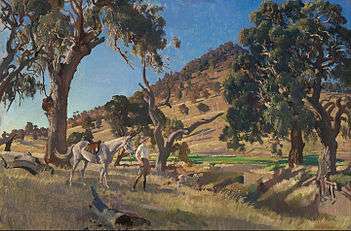
The Squattocracy have historically retained close ties to Britain. Many families retained properties in both Britain and Australia, often retiring to Britain after making their fortune and leaving vast stretches of land to be controlled by hired staff or younger sons.[7]
Prominent Australian families from the "squattocracy" include:
- The Kidman family who held 107,000 square miles worth of land in Central Australia.[8] Members and relatives include Nicole Kidman and the "Cattle Baron" Sydney Kidman.
- The Ellis family of South Australia.[9]
- The Forrest family of Western Australia who have produced a number of conservative politicians for the Liberal Party; Alexander Forrest, David Forrest, John Forrest (Western Australia's first Premier) and Mervyn Forrest.
- The Gilbert family of South Australia.[10]
- The Baillieu family of Victoria who were awarded the title of Baron's Baillieu in recognition for the immense contributions to Australian society made by the politician and financier Sir Clive Baillieu, son of public legend William Baillieu, after whom the Baillieu library at Melbourne University is named.
Cultural resonances
Literature: The power of the squatters, including their affinity with the police, is referenced in Banjo Paterson's "Waltzing Matilda", Australia's most famous folk song.
Clara Morison by Catherine Helen Spence explores the power of Australia to transform those with a lowly social station in Britain into the Aristocracy of a new world.[11]
Mary Theresa Vidal's 1860 novel Bengala is an Austenesque social comedy exploring the evolution of the pseudo-aristocratic manners which define the squattocracy.[12]
In Miss Fisher's Murder Mysteries, the title character, The Honourable Phyrne Fisher, is resistant to her class and acts as a contrast to her Aunt Prudence, who typifies grazier and squattocracy snobbery.
The film Australia deals with the failure of many large grazier properties in the mid-twentieth century, as well as the Squattocracy's close historic links with the British Aristocracy, with whom they frequently intermarried. The film's star, Nicole Kidman, is herself a relative of the prominent Squatter family the Kidmans, who, at the height of their power, held 107,000 square miles worth of land in Central Australia.[13]
References
- Hodgson, Christopher Pemberton (1846). Reminiscences of Australia with Hints on the Squatter's Life. Pall Mall: W.N. Wright. p. 13. Retrieved 9 February 2018.
- La Croix, Sumner J., ‘Sheep, Squatters, and the Evolution of Land Rights in Australia: 1787-1847’ (University of Hawaii-Manoa) – paper presented at "Inequality and the Commons”, 3rd annual conference of the International Association for the Study of Common Property, Washington DC, USA, 18–20 September 1992.
- Denholm, David, ‘Squatting’, The Oxford Companion to Australian History, edited by Graeme Davidson, John Hirst & Stuart MacIntyre, Oxford University Press, 1998.
- Heaton, J.H. 1984, The Bedside Book of Colonial Doings, Angus and Robertson, Sydney, published in 1879 as Australian Dictionary of Dates containing the History of Australasia from 1542 to May 1879, p.226)
- Roberts, Stephen H., History of Australian Land Settlement, 1788-1920, Macmillan / Melbourne University Press, Melbourne, 1924.
- "South Australia - Miscellany: Squatters and Pastorists". The Manning Index of South Australian History. Retrieved 5 August 2019 – via State Library of South Australia.
- "A South-Eastern Estancia". The Border Watch. Mount Gambier, SA: National Library of Australia. 19 January 1943. p. 5. Retrieved 1 August 2012.
- ""Cattle King" dead.". The Northern Miner. Charters Towers, Queensland: National Library of Australia. 3 September 1935. p. 2. Retrieved 2 May 2013.
- The Benara Estate". South Australian Register. Adelaide: National Library of Australia. 23 October 1874. p. 4. Retrieved 31 July 2012.
- https://trove.nla.gov.au/newspaper/article/37302827
- Victorian Settler Narratives: Emigrants, Cosmopolitans and Returnees in Nineteenth-Century Literature, Tamara S Wagner, Routledge, 6 Oct 2015
- Victorian Settler Narratives: Emigrants, Cosmopolitans and Returnees in Nineteenth-Century Literature, Tamara S Wagner, Routledge, 6 Oct 2015
- ""Cattle King" dead.". The Northern Miner. Charters Towers, Queensland: National Library of Australia. 3 September 1935. p. 2. Retrieved 2 May 2013.